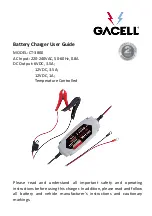
Federal law mandates that tire manufacturers place standardized information on the sidewall of all tires (see the
illustration).
The following information is listed on the tire sidewall:
The tire designation (the following figures are examples of a tire designation):
1.
215
: the width of the tire (in millimeters) from sidewall edge to sidewall edge. The larger the number, the wider the
tire.
2.
65
: The ratio of the tire's height to its width.
3.
R
: Radial tire.
4.
15
: The diameter of the wheel rim (in inches).
5.
95
: The tire's load index. In this example, a load index of 95 equals a maximum load of 1521 lbs (690 kg).
6.
H
: The tire's speed rating, or the maximum speed at which the tire is designed to be driven for extended periods of
time, carrying a permissible load for the vehicle, and with correct inflation pressure. For example, H indicates a speed
rating of 130 mph (210 km/h).
NOTE
This information may not appear on the tire because it is not required by law.
7.
M+S
or
M/S
= Mud and Snow,
AT
= All Terrain,
AS
= All Season
8.
U.S. DOT Tire Identification Number (TIN)
: This begins with the letters "DOT" and indicates that the tire meets
all federal standards. The next two numbers or letters are the plant code where it was manufactured, the next two are
the tire size code and the last four numbers represent the week and year the tire was built. For example, the numbers
317 mean the 31st week of 1997. After 2000 the numbers go to four digits. For example, 2501 means the 25th week of
2001. The numbers in between are marketing codes used at the manufacturer's discretion. This information helps a tire
manufacturer identify a tire for safety recall purposes.
9.
Tire Ply Composition and Material Used
: Indicates the number of plies indicates or the number of layers of
rubber-coated fabric in the tire tread and sidewall. Tire manufacturers also must indicate the ply materials in the tire
and the sidewall, which include steel, nylon, polyester, and others.
10.
Maximum Load
: Indicates the maximum load in pounds and kilograms that can be carried by the tire. Refer to the
vehicle's tire information placard or the safety certification label, located on the B-Pillar or the driver's door or on the
inside of the fuel filler door on Canadian models, for the correct tire pressure for your vehicle.
11.
Treadwear, Traction, and Temperature grades
for more information.
12.
Maximum permissible inflation pressure
: the greatest amount of air pressure that should ever be put in the tire.
This limit is set by the tire manufacturer.
227
06 Maintenance and specifications
Glossary of tire terminology
The tire suppliers may have additional markings, notes or warnings such as standard load, radial tubeless, etc.
Summary of Contents for 2007 S80
Page 106: ...Contents Top of Page...
Page 165: ...167 04 Comfort and driving pleasure This page left intentionally blank Contents Top of Page...
Page 206: ...Engine compartment upper Engine compartment front Engine compartment lower Positions...
Page 209: ...214 06 Maintenance and specifications Fuses 215 06 Maintenance and specifications Fuses Trunk...
Page 210: ...Positions...
















































